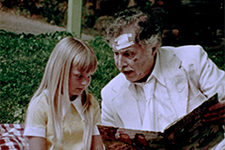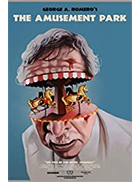The Amusement Park
|  To many, George A. Romero will always be a director of zombie movies. His first feature, Night of the Living Dead (1968), was a seminal horror film, one of a handful of efforts that genuinely altered the genre and introduced a frightening new concept—in this case, hoards of ravenous reanimated corpses—that would form the backbone of an entire subgenre. His subsequent “Dead” films—Dawn of the Dead (1978), Day of the Dead (1985), Land of the Dead (2005), Diary of the Dead (2007), and Survival of the Dead (2009)—vary greatly in terms of quality, but they always have something interesting and prescient to say because Romero was, at heart, a social filmmaker. Through the blood and gore and shambling dead he aimed to deconstruct some of the fundamental institutions of American society, particularly capitalism, the family, and the military. Romero’s films, when taken as a whole, construct a bleak portrait of American exceptionalism that is founded on greed, tyranny, and exploitation. And, while most of those films fall comfortably into horror, he worked in a range of genres, as evidenced by films like the counterculture drama There’s Always Vanilla (1971) and the action-fantasy Knightriders (1981) (he even directed part of an episode of Mr. Roger’s Neighborhood, in which Mr. Rogers has his tonsils removed). People also forget (or maybe never knew) that he began his career in the 1960s making commercials and industrial films and documentaries, the experience of which informed his low-budget ingenuity and ability to work in a wide range of registers (Night of the Living Dead works as well as it does because it often feels like a documentary). Which brings us to The Amusement Park, a hitherto “lost” Romero film that he directed in 1973 as a commissioned work for two Christian organizations, the Lutheran Society of Western Pennsylvania and the Pitcairn Crabbe Foundation. Prior to its resurrection a few years ago, the film had scarcely been mentioned and was either unknown or forgotten. Paul R. Gagne’s book The Zombies That Ate Pittsburgh: The Films of George A. Romero, an otherwise comprehensive accounting of the first two decades of Romero’s career, doesn’t even mention it. One of the only people to write about it has been film scholar Tony Williams, author of The Cinema of George A. Romero: Knight of the Living Dead. Romero screened it for him in 1979, and he subsequently wrote a glowing article in the only issue ever published of the magazine Cinema Spectrum: The Film Magazine of Fantasy & Imagination in 1980. In an interview published in Quarterly Review of Film and Video in 2001, Romero basically shrugged off Williams’s question about whether he would ever release it, saying, “I haven’t seen it for years.” (One wonders if Romero is referring to having not watched the film in years or literally not knowing the location of his copy.) But now, here we are, and against all odds, The Amusement Park has been restored from a faded 16mm print and is currently streaming on Shudder, releasing it from the purgatory in which it has moldered since it was produced and shelved decades ago. Romero had been commissioned to make a short public service film about ageism and the plight of the elderly in America, but the film he submitted was so bleak and despairing and disturbing that it was never released. One can immediately see why: While fundamentally allegorical in nature, The Amusement Park is nevertheless a visceral film that puts into stark relief the manner in which the elderly are mistreated socially, psychologically, and physically. The film begins and ends with the lead actor, Lincoln Maazel, who also played a key role in Romero’s Martin (1978), walking through a chilly, deserted amusement park ruminating on the nature of old age and setting up the film’s primary themes. (This prologue and epilogue were apparently added after the fact to try to contextualize the film’s hard edges and bleak visuals, but it clearly wasn’t enough.) The majority of the film, which was written by the otherwise completely unknown Wally Cook, follows Maazel’s character, an unnamed elderly man in a crisp white suit, as he walks through an amusement park, different points of which dramatize how men and women of his age are treated in American society (the film was shot at West View Park in West View, Pennsylvania, which was first opened in 1905 and was nearing the end of its life at the time). We know that things will be bad because, before he steps into the amusement park, he is confronted with a bloodied, beaten, and despondent version of himself who tells him that there is nothing good out there, an ominous warning that he blithely ignores. In the park, we see Maazel and other elderly people (all of whom are non-actors and many of whom were living in nursing homes at the time) exploited financially, ignored, shoved aside, and blamed for things they didn’t do. The violence enacted against Maazel and the others is sometimes physical (hence his bloodied appearance by the end), but it is just as often rhetorical and emotional, giving sharp visualization to the systemic nature of his mistreatment. The disturbing point of the film is that the horrors visited upon Maazel in the amusement park (which Romero punctuates with fleeting glimpses of a scythe-wielding Death) are not isolated or manageable with a few policy changes, but are rather built into the American way of life, where your worth is predicated upon your ability to perform and produce. The elderly, with their walkers and canes and limited vision and slow reactions are deemed worthless in a materialistic society that sees everyone as a commodity (five years later Romero applied these themes to Dawn of the Dead). The Amusement Park was made during a difficult period in Romero’s career; he had failed to replicate the financial and critical success of Night of the Living Dead with his subsequent features, There’s Always Vanilla, Season of the Witch (1972), and The Crazies (1973). His production company, The Latent Image, was falling apart, and Romero was trying to rebuild via a new company, Laurel, and a new business partner, Richard P. Rubinstein. Rubinstein insisted that Romero steer clear of feature films for a while, so they spent several years making television productions and documentaries, notably the 17-episode The Winners series that profiled notable athletes like Reggie Jackson, Kareem Abdul-Jabbar, and Franco Harris (1974–75). It was within this context that he produced The Amusement Park, and you can sense in every canted frame and shock cut Romero wanting to break out of the strictures of the kind of commissioned commercial production with which he began his career. Working with many of his regular collaborators—notably Rubenstein, cinematographer William Hinzman, and sound designer and cameraman Michael Gornick—Romero took what could have been a run-of-the-mill public service announcement and turned it into something genuinely unsettling. Copyright © 2021 James Kendrick Thoughts? E-mail James Kendrick All images copyright © The George A. Romero Foundation and IndieCollect |
Overall Rating: 


 (3.5)
(3.5)


